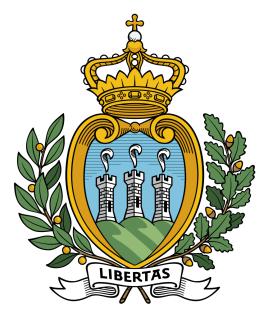

The Republic of San Marino (Italian: Republica di San Marino) is one of the smallest countries in the world. It is located in the south of Europe and in the east of the Italian peninsula. The whole country is surrounded by Italy. The terrain is dominated by the central Titano mountain (738 meters above sea level), and the hills extend to the southwest. The northeast is a plain with the San Marino River and Marranos river flowing through it. It has a subtropical Mediterranean climate with a total area of 61.2 square kilometers.
San Marino's stamps are only domestically valid, and most of them are sold to stamp collectors, forming a source of income.
San Marino's industry and commerce are mainly banking, electronic manufacturing and ceramic manufacturing, while the agricultural products are wine and cheese. In 1992, San Marino became a member of the United Nations.
San Marino terrain is affected by the Apennine mountains, the territory is rugged and mountainous. It is located in the highest point of the central Titano mountain, with an altitude of 755.24 meters. There is no obvious water system in San Marino. San Marino has a subtropical Mediterranean climate, which is hot and dry in summer and mild and rainy in winter. Since it is located in high mountains and high altitude, the temperature is slightly lower in summer and cooler in winter. The annual average temperature is 16 ℃, the minimum temperae in winter is -2 ℃, and the maximum temperature in summer is 30 ℃, the average annual precipitation is 880 mm.
San Marino, the capital of San Marino, is located in the central part of the country on the western slope of Titano. It has many places of interest and developed tourism. San Marino is built on the hillside of Titiano, with a population of less than 5000.
The main agricultural products of San Marino are grape wine and cheese. San Marino's main industries are banking, electronic manufacturing and ceramic manufacturing. Small and medium-sized enterprises are the mainstay of San Marino's economy. They are mainly clothing, machinery manufacturing, electronic equipment, chemical industry, construction and wine making. Industrial output value and handicraft industry output value account for 25% and 10% of national income respectively.
In terms of tourism, there were more than 3.3 million tourists in 1997, contributing more than 50% of San Marino's GDP. After the 1960s, San Marino's tourism, commerce and industry continued to develop, and the economic structure changed fundamentally. It gradually changed from an agricultural country to a country with developed industries and tertiary industries, and its gross domestic product increased significantly. In 10 years, the tertiary industry has developed rapidly, accounting for 34.4% of the employed population in 2002. Tourism and stamp issue are important sources of national income. San Marino's economy is stable, reflected in low unemployment, a state budget balance and no national debt. San Marino's export GDP and people's living standards can be compared with Italy, which provides a lot of food.
